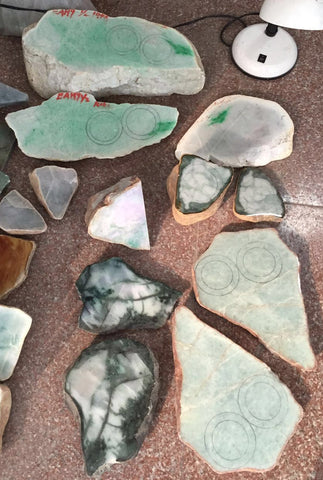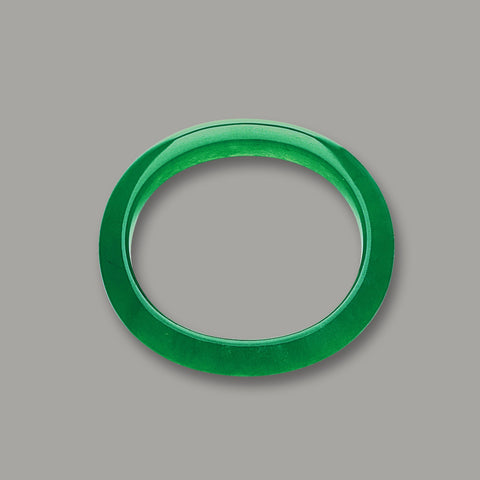 Jade bangles come in a multitude of variations. In general, jade bangles are the most common form of jade jewellery and are probably jade in their most recognizable form.
Jade bangles come in a multitude of variations. In general, jade bangles are the most common form of jade jewellery and are probably jade in their most recognizable form.
Due to its hollow circular shape, producing a single jade bangle would require a large piece of raw jade. As a result, quality jade bangles are much rarer as compared to other jade jewellery in other forms. Larger blocks of good quality jade are significantly much harder to find. As such, quality jade bangles also increase in price substantially with the increment in thickness of the bangle.
The image on the right illustrates how blocks of jade are selected for carving out jade bangles. Any single crack line on a block of jade will render the block unusable for carving jade bangles.
Different Types of Bangles
Material
Jade bangles, like all jade jewellery, can be firstly split into 2 main categories: Jadeite and nephrite bangles. Differences between jadeite and nephrite are fundamental and affect everything about the jade, from colour to lustre.
Colour
Jade bangles come in all sorts of colours. Since jade bangles need to be carved out from a single block of jade, finding good quality jade bangles with beautiful green shades are exceptionally rare. A sample of some of the colours available for jade bangles is shown here:

Shape
The shape of a bangle will determine the fit of a bangle worn on the wrist. There are 2 main shapes that jade bangles are designed in. Jade bangles are either oval in shape or circular in shape.
| Round Shaped Jade Bangle |
Oval Shaped Jade Bangle |
 |
 |
Cut (Cross Sectional Dimensions)
Traditionally, bangles are cut and polished to be circular in both shape and cross sectional dimensions. This requires the most raw materials due to the bevels required to achieve the round cross sections. There have been introductions to jade design both out of practicality, functionality and perhaps style.
Today, jade bangles can mainly be found in 4 different kinds of cut: Rounded-square, round, inner bevelled and bevelled (outer and inner).

Bevelling the surface of the bangle allows for the removal of imperfections that would otherwise allow for a round bangle to be made. It also makes for a more comfortable fit if the bevelling is done on the inner side of the bangle. Having straight lines provides a cleaner silhouette and appeals to a more modern fit for an otherwise traditional form of jewellery.
Tips on Wearing Jade Bangles
Jade bangles typically have no opening mechanism built in, unlike bracelets. Thus, the fit of a jade bangle is very important. If a bangle is too large, the bangle might not necessarily fall off but this increases the incidences of accidentally hitting the jade bangle against objects, thereby causing it to break. If a bangle is too small, the act of wearing the bangle is actually impossible without breaking some bones. So, to choose and wear a good fitting jade bangle, some bearable pain has to be endured. Here are some tips to reduce the discomfort of squeezing one’s hands through a bangle and to wear a bangle that fits well on the wrist.
Lubricate
The easiest way to get a jade bangle into one’s hand is to use soap as a lubricant. Lubricating the hand and the jade bangle will reduce friction to allow the bangle to slip over the hand. Any sort of lubricant will help and using soap is beneficial since that also cleans the jade bangle at the same time.
Hand creams are another form of lubrication and are very useful in situations where soap and water are not available. Moreover, unlike pearls and coral, jade is not affected by creams or soap, allowing people to wear their bangles all the time even while bathing.
Using Plastic Bags
At most physical jade shops, the go-to method for trying out jade bangles would be to use a thin plastic bag. The plastic bag would be placed over the wearer’s hand before slipping the jade bangle over the wearer’s hand. The jade bangle will not be in contact with any skin and this works just like a lubricant. The benefit is that the wearer does not have to come into contact with any chemicals. A pictorial guide illustrating how this can be done can be found in the link here.
Getting A Friend To Help
Fitting into a jade bangle might not be the easiest thing to do. Even with considerable amounts of soap and water, sometimes, it is hard to squeeze into a jade bangle. Thus, having someone around to help out would be useful.
Bangle Sizing
Purchasing a bangle will depend highly on personal preferences due to the number of variations available for selection. However, to begin any selection, one should filter the available options by the size of one’s hands and wrist. Sizes of hands differ from person to person and this should be used to filter out the bangles that can be bought and worn comfortably (without breaking any bones).
Wearing a bangle involves squeezing ones hands to create the smallest circumference possible and slotting the hand through the bangle. Thus, to know the size of bangles that can be worn, one has to identify the minimum circumference of one’s squeezed hands. A pictorial illustration of measuring the minimum circumference can be seen from steps 4 – 8 of this link.
The minimum circumference of one’s hands depends greatly on the flexibility of one’s bones. Most jade bangles provide inner diameter specifications but not the circumference. Thus, as a guideline, using the calculation for circle circumferences, a table is provided below for quick reference.
| Hand Circumference |
Minimum Bangle Diameter |
| 157 - 163 mm |
50 - 52 mm |
| 163 - 170 mm |
52 - 54 mm |
| 170 - 176 mm |
54 - 56 mm |
| 176 - 182 mm |
56 - 58 mm |
| 182 - 188 mm |
58 - 60 mm |
| 188 - 195 mm |
60 - 62 mm |
| 195 - 201 mm |
62 - 64 mm |
| 201 - 207 mm |
64 - 66 mm |
| 207 - 214 mm |
66 - 68 mm |
The sizing guideline is calculated with the assumption that the jade bangle is of a circular shape and should only be taken as a reference. Whether one can wear a bigger size is dependent on one’s comfort level. A loose fitting jade bangle might feel insecure as it might drop off accidentally. Whether one can wear a smaller size, is really dependent on one’s ability to endure pain (It is quite painful to squeeze into a smaller sized bangle).
The only way to be perfectly sure that a jade bangle fits is to try out the bangle in person. The next best option is to purchase jade bangles identical to an existing jade bangle that fits. However, being able to fit into a round bangle of certain size does not necessary mean that one is still able to fit into an oval shaped jade bangle of the same size.
Buying Jade Bangles
An assortment of jade bangles can be purchased online and offline. However, if you wish to purchase a jade bangle for the first time and you are physically in Singapore, please do drop by at our physical shop, at 54 Smith Street, to understand the best fit for your hand. As much as we would like to be an online store, buying jade bangles is really quite a physical affair.
SaveSaveSaveSave
SaveSaveSaveSave



 Jade bangles come in a multitude of variations. In general, jade bangles are the most common form of jade jewellery and are probably jade in their most recognizable form.
Jade bangles come in a multitude of variations. In general, jade bangles are the most common form of jade jewellery and are probably jade in their most recognizable form.


